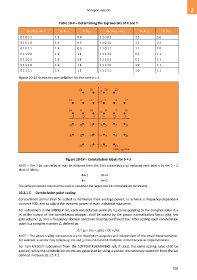Page 779 - 5G Basics - Core Network Aspects
P. 779
Transport aspects 2
Table 10-4 – Determining the top two bits of X and Y
vb–1 vb–2...vb–5 Xc Xc–1 Yc Yc–1 vb–1 vb–2...vb–5 Xc Xc–1 Yc Yc–1
0 1 0 0 1 1 1 0 0 1 1 0 0 1 1 1 1 0
0 1 0 1 0 1 1 0 0 1 1 0 1 0 1 1 0 1
0 1 0 1 1 1 1 0 0 1 1 0 1 1 1 1 1 0
0 1 1 0 0 1 1 1 1 1 1 1 0 0 0 1 1 1
0 1 1 0 1 1 1 1 1 1 1 1 0 1 0 1 1 1
0 1 1 1 0 1 1 1 1 1 1 1 1 0 1 0 1 1
0 1 1 1 1 1 1 1 1 1 1 1 1 1 1 0 1 1
Figure 10-14 shows the constellation for the case b = 5.
Figure 10-14 – Constellation labels for b = 5
NOTE – The 7-bit constellation may be obtained from the 5-bit constellation by replacing each label n by the 2 × 2
block of labels:
4n+1 4n+3
4n 4n+2
The same procedure may then be used to construct the larger odd-bit constellations recursively.
10.2.1.5 Constellation point scaling
Constellation points shall be scaled to normalize their average power, to achieve a frequency-dependent
transmit PSD, and to adjust the transmit power of each individual subcarrier.
For subcarriers in the MEDLEY set, each constellation point (Xi, Yi), corresponding to the complex value Xi +
jYi at the output of the constellation mapper, shall be scaled by the power-normalization factor χ(bi), the
gain adjuster gi, and a frequency-domain spectrum shaping coefficient tssi. After scaling each constellation
point is a complex number Zi, defined as:
Zi = gi tssi (bi) (Xi + jYi).
NOTE – The above scaling components are for description purposes and independent of the actual implementation.
For example, a vendor may collapse gi, tssi and i into one transmit multiplier in the transceiver implementation.
For non-MEDLEY subcarriers from the SUPPORTEDCARRIERS set, if used, the same scaling rules shall be
applied, while the constellation points are generated by using a vendor discretionary selection from the set
defined in clause 10.2.1.4.2.
769

